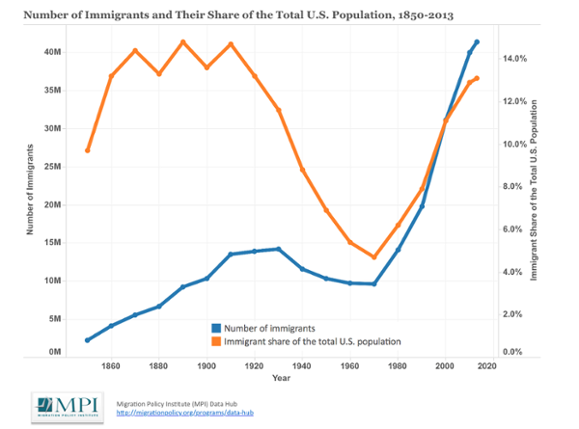
The Migration Policy Institute notes that the number of immigrants living in the US has recently reached historically high levels, however the percentage of immigrants to population has just reached the levels that were common prior to the 1921 Emergency Quota Act (The Immigration Restriction Act of 1921).
In 1965, the restrictions of 1921 were lifted when the Hart-Celler Act was passed with strong bi-partisan support with the aim in mind of doing away with racial and ethnic restrictions in the previous immigration law and opening the way for people who possessed needed intellectual and scientific skills to enter our workforce. On October 3, 1965, at the foot of the Statue of Liberty, President Lyndon Johnson signed the Hart-Celler Act into law saying, “This bill we sign today is not a revolutionary bill. It does not affect the lives of millions. It will not restructure the shape of our daily lives or add importantly to either our wealth or power.” President Johnson’s statement could not have been farther off the mark.
Over the past 50 years, the bill has opened the door to much greater cultural diversity in the make-up of our nation and at the same time has made our nation more Christian. In his brilliant 2007 book,The Next Christendom, Phillip Jenkins wrote, “Far from what anyone could have dreamed at the time, the 1965 Immigration Act had vast consequences for American religion, especially Christianity. At least 66 percent of new immigrants are Christian, compared to just 8 percent Muslims.”
Change is difficult for anyone and greater cultural diversity has brought change. When my wife and I go for walks in local parks, we will often see pick-up cricket matches and soccer games while the nearby softball fields wait for organized evening games to start. Our neighborhood is composed of people of European, Asian, Middle Eastern, and African descent.
Most American churches celebrate an old model of missions that aims at reaching the ends of the earth by sending and supporting overseas missionaries. As immigration has grown, America has become more diverse and the world has come to our cities. Many of these new residents are our fellow Christians. What would happen if these same institutions became missional churches with a local focus on the many peoples who have come to our cities? What would happen if American churches rolled out the red carpet to welcome Christians from the many parts of the world who have come to us? What would happen if both immigrants and long time residents worked to more thoughtfully welcome with Christian hospitality those who come from the many unreached people groups as refugees?
As GoodCities is seeking to make an impact, we are being sensitive to the need to better extend hospitality to immigrants. Leaders related to GoodCities are key bridge builders who are doing this work in a number of cities. Those that stand out in my mind are in Dallas through Unite Greater Dallas, Modesto through City Ministry Network, and Minneapolis through Transform Minnesota and Arrive Ministries.
Please share with us what Christians are doing in your city to welcome immigrants and refugees. We’d love to hear your stories. Join with us to hear these kind of stories at City Convene in Cincinnati, Sept 21-22.
City Convene
*(http://www.migrationpolicy.org/programs/data-hub/charts/immigrant-population-over-time?width=1000&height=850&iframe=true accessed 8-24-2015).
